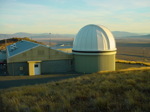Astronomy Seminar
| Date/Time: | Friday, 12 Jun 2015 at 4:10 pm |
|---|---|
| Location: | 18 Physics |
| Contact: | Steve Kawaler, Physics and Astronomy |
| Phone: | 515-294-5440 |
| Channel: | College of Liberal Arts and Sciences |
| Categories: | Lectures |
| Actions: | Download iCal/vCal | Email Reminder |
The Music of the Stars: Using Surface Vibrations to Deduce the Structure of Stars
Stars are opaque, so how can we work out their interior structure and the physical processes that are occurring inside them? Asteroseismology is the science of deducing stellar interiors from observations of a star's surface oscillations. By monitoring a star's tiny surface vibrations with a precision spectrograph, we can calculate that star's unique frequencies and modes of vibration, which are governed by its interior structure. In this way, we can obtain tight constraints on the physical conditions within the star.
In this talk, I will describe our observing programme at the University of Canterbury's Mt John Observatory, where we obtain extensive high-resolution echelle spectra of non-radially pulsating stars. We analyze these to obtain the pulsational frequencies and identify these with the multiple pulsational modes excited in the star. I will present a summary of our observational program and some recent results from our spectroscopic frequency and mode-identification analysis.
----
KMTNet: Detecting distant extrasolar planets
Crowded regions of the sky present a significant challenge for stellar photometry. I will
describe the new KMTNet experiment, and discuss how we use difference-imaging to
extract the signals from variable stars from the background of constant-brightness objects.
I will briefly discuss the use of Graphical Processing Units (GPUs) for parallel computations
in astrophysics, and describe pyDIA, a new GPU-based code for wide-field difference-imaging
photometry.
